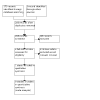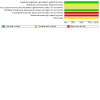Tourniquet use for people with peripheral arterial disease undergoing major lower limb amputations
- PMID: 37462258
- PMCID: PMC10355878
- DOI: 10.1002/14651858.CD015232.pub2
Tourniquet use for people with peripheral arterial disease undergoing major lower limb amputations
Abstract
Background: At least 7000 major lower limb amputations (MLLAs) are performed in the UK each year, 80% of which are due to peripheral arterial disease (PAD). Intraoperative blood loss can have a deleterious effect on patient outcomes, and its replacement with transfused blood is not without risk. Tourniquets can be used in lower limb surgical procedures to provide a bloodless surgical field, minimise intraoperative blood loss, and reduce perioperative blood transfusion requirements. Although their safety has been demonstrated in certain orthopaedic operations, their use among people with PAD undergoing MLLA remains controversial. Many clinicians are concerned about tourniquets potentially compromising perfusion of the stump and thereby impacting wound healing through direct tissue injury, damage to the arterial supply of the wound, or both.
Objectives: To assess the safety and effectiveness of tourniquet use in people undergoing MLLA for complications of PAD, specifically with regard to intraoperative blood loss, change in haemoglobin levels, transfusion rates, wound healing, need for revision surgery, and postoperative complications including mortality.
Search methods: We searched the Cochrane Vascular Specialised Register, CENTRAL, MEDLINE, Embase, and CINAHL databases and World Health Organization International Clinical Trials Registry Platform and ClinicalTrials.gov trials registers from inception to 17 May 2022.
Selection criteria: We included randomised controlled trials (RCTs) comparing tourniquet use to no tourniquet use among people with PAD undergoing MLLA.
Data collection and analysis: We used standard Cochrane methods. Primary outcomes were intraoperative blood loss, fall in haemoglobin levels, and perioperative blood transfusion requirement. Secondary outcomes were primary wound-healing rates, stump revision rates, other postoperative complications defined as per Clavien-Dindo classification, and postoperative mortality at 30 days and at maximal follow-up. We used GRADE to assess the certainty of evidence for each outcome.
Main results: One RCT met our inclusion criteria, which was a prospective randomised blinded controlled trial conducted in Sheffield, UK in 2006. In total 64 participants undergoing transtibial amputation for non-reconstructable PAD were randomised to either tourniquet or no tourniquet to assess for intraoperative blood loss, fall in haemoglobin, transfusion requirement, wound healing, stump breakdown and revision. Ten participants were excluded postrandomisation (five from the tourniquet group and five from the no tourniquet group). The reported median volume of intraoperative blood loss was significantly less in the tourniquet group (255 mL (interquartile range (IQR) 150 to 572.5 mL))) compared to the control group (550 mL (IQR 255 to 1050 mL)) (P = 0.014). There was a significantly lower median drop in haemoglobin concentration in the tourniquet group (1.0 g/dL (IQR 0.6 to 2.4 g/dL)) compared to the control group (1.8 g/dL (IRQ 0 to 1.2 g/dL)) (P = 0.035). There was a significantly lower perioperative blood transfusion requirement in the tourniquet group (8 participants, 32%) compared to the control group (14 participants, 48%) (P = 0.047). There were no clear differences in wound breakdown, stump revision, primary wound healing at six weeks, postoperative complications (myocardial infarction, cardiac arrhythmias, pulmonary oedema), and death between groups. We assessed the one included study as at low risk of bias for sequence generation and blinding of outcome assessors; high risk of bias for incomplete outcome data and selective outcome reporting; and unclear risk of bias for allocation concealment, blinding of participants and personnel, and other sources of bias. We assessed the certainty of the evidence as low or very low due to risk of bias, small sample size, and the study being insufficiently powered for most outcomes.
Authors' conclusions: This review identified only one small historical RCT evaluating tourniquet use in MLLA. Tourniquets appeared to reduce intraoperative blood loss, drop in haemoglobin, and blood transfusion requirements following transtibial amputations for people with PAD. However, it is unclear whether tourniquets affect wound healing, stump revision rates, postoperative complications, or mortality. High-certainty evidence is required to inform clinical decision-making for the use of tourniquets in these patients.
Copyright © 2023 The Cochrane Collaboration. Published by John Wiley & Sons, Ltd.
Conflict of interest statement
RL: none known; RL indicates they are a Vascular Surgery Trainee at Leeds Teaching Hospitals Trust, Leeds, UK.
MD: none known
BG: none known; BG indicates they are a Vascular Surgery Registrar in Aneurin Bevan University Health Board.
OR: none known; OR reports they are a doctor at University Hospital Wales.
AM: none known; AM indicates they are a Consultant surgeon for NHS Wales.
DB: none known
Figures
Update of
- doi: 10.1002/14651858.CD015232
Similar articles
-
Drugs to reduce bleeding and transfusion in major open vascular or endovascular surgery: a systematic review and network meta-analysis.Cochrane Database Syst Rev. 2023 Feb 17;2(2):CD013649. doi: 10.1002/14651858.CD013649.pub2. Cochrane Database Syst Rev. 2023. PMID: 36800489 Free PMC article.
-
Lumbar sympathectomy versus prostanoids for critical limb ischaemia due to non-reconstructable peripheral arterial disease.Cochrane Database Syst Rev. 2018 Apr 16;4(4):CD009366. doi: 10.1002/14651858.CD009366.pub2. Cochrane Database Syst Rev. 2018. PMID: 29658630 Free PMC article.
-
Drugs for preventing postoperative nausea and vomiting in adults after general anaesthesia: a network meta-analysis.Cochrane Database Syst Rev. 2020 Oct 19;10(10):CD012859. doi: 10.1002/14651858.CD012859.pub2. Cochrane Database Syst Rev. 2020. PMID: 33075160 Free PMC article.
-
Interventions for motor rehabilitation in people with transtibial amputation due to peripheral arterial disease or diabetes.Cochrane Database Syst Rev. 2023 Jun 5;6(6):CD013711. doi: 10.1002/14651858.CD013711.pub2. Cochrane Database Syst Rev. 2023. PMID: 37276273 Free PMC article.
-
Non-surgical interventions for preventing contralateral tissue loss and amputation in dysvascular patients with a primary major lower limb amputation.Cochrane Database Syst Rev. 2024 Aug 28;8(8):CD013857. doi: 10.1002/14651858.CD013857.pub2. Cochrane Database Syst Rev. 2024. PMID: 39193872
References
References to studies included in this review
Choksy 2006 {published data only}
-
- Choksy SA, Lee Chong P, Smith C, Ireland My, Beard J. A randomised controlled trial of the use of a tourniquet to reduce blood loss during transtibial amputation for peripheral arterial disease. European Journal of Vascular and Endovascular Surgery 2006;31(6):646–50. - PubMed
References to studies excluded from this review
Cagney 2021 {published data only}
-
- Cagney D, Byrne J, Fulton GJ, Manning BJ, Redmond HP. The role of tourniquets in transtibial amputation for peripheral vascular disease: a systematic review and meta-analysis. British Journal of Surgery 2021;108(Suppl 1):i21.
Additional references
Ahmad 2016
-
- Ahmad N, Thomas GN, Gill P, Torella F. The prevalence of major lower limb amputation in the diabetic and non-diabetic population of England 2003-2013. Diabetes and Vascular Disease Research 2016;13(5):348-53. - PubMed
Ajibade 2013
Atkins 2004
Beall 2013
-
- Beall J. Five predatory mega-journals: a review. The Charleston Advisor 2013;14(4):20-5.
Behrendt 2018
-
- Behrendt CA, Sigvant B, Szeberin Z, Beiles B, Eldrup N, Thomson IA, et al. International variations in amputation practice: a VASCUNET report. European Journal of Vascular and Endovascular Surgery 2018;56(3):391-9. - PubMed
Biehl 1993
-
- Biehl WC 3rd, Morgan JM, Wagner FW Jr, Gabriel RA. The safety of the Esmarch tourniquet. Foot and Ankle 1993;14(5):278-83. - PubMed
Bosanquet 2021
-
- Bosanquet DC, Nandhra S, Wong KH, Long J, Chetter I, Hinchliffe RJ. Research priorities for lower limb amputation in patients with vascular disease. Journal of Vascular Societies Great Britain and Ireland (JVSGBI) 24 November 2021;1:11-16.
Brand 1998
-
- Brand FN, Kannel WB, Evans J, Larson MG, Wolf PA. Glucose intolerance, physical signs of peripheral artery disease, and risk of cardiovascular events: the Framingham Study. American Heart Journal 1998;136(5):919-27. - PubMed
Brownrigg 2016
-
- Brownrigg JR, Hinchliffe RJ, Apelqvist J, Boyko EJ, Fitridge R, Mills JL, et al, on behalf of the International Working Group on the Diabetic Foot (IWGDF). Performance of prognostic markers in the prediction of wound healing or amputation among patients with foot ulcers in diabetes: a systematic review. Diabetes/Metabolism Research and Reviews 2016;32(Suppl 1):128-35. - PubMed
Bruce 2002
Choksy 2006
-
- Choksy SA, Lee Chong P, Smith C, Ireland M, Beard J. A randomised controlled trial of the use of a tourniquet to reduce blood loss during transtibial amputation for peripheral arterial disease. European Journal of Vascular and Endovascular Surgery 2006;31(6):646-5. - PubMed
Clavien 2009
-
- Clavien PA, Barkun J, Oliveira ML, Vauthey JN, Dindo D, Schulick RD, et al. The Clavien-Dindo classification of surgical complications: five-year experience. Annals of Surgery 2009;250(2):187-96. - PubMed
Conte 2019
Coulston 2012
-
- Coulston JE, Tuff V, Twine CP, Chester JF, Eyers PS, Stewart AH. Surgical factors in the prevention of infection following major lower limb amputation. European Journal of Vascular and Endovascular Surgery 2012;43(5):556-60. - PubMed
Covidence [Computer program]
-
- Covidence. Melbourne, Australia: Veritas Health Innovation, accessed 23 February 2022. Available at www.covidence.org.
Cunin 2019
-
- Cunin L, Balakumar C, Kennedy L, Gordon-Dixon A, Senaratne J, Rix T. A review of the implications of perioperative blood transfusion in patients undergoing vascular surgery. Annals of Vascular Medicine 2019;2(1):1009.
Curran 2014
D'Ayala 2010
-
- D'Ayala M, Huzar T, Briggs W, Fahoum B, Wong S, Wise L, et al. Blood transfusion and its effect on the clinical outcomes of patients undergoing major lower extremity amputation. Annals of Vascular Surgery 2010;24(4):468-73. - PubMed
Dilaver 2020
Fowkes 2013
-
- Fowkes FG, Rudan D, Rudan I, Aboyans V, Denenberg JO, McDermott MM, et al. Comparison of global estimates of prevalence and risk factors for peripheral artery disease in 2000 and 2010: a systematic review and analysis. The Lancet 2013;382(9901):1329-40. [DOI: 10.1016/S0140-6736(13)61249-0] - DOI - PubMed
Glaser 2016
-
- Glaser JD, Ecker B, Fairman RM, Karakousis G, Damrauer SM. Trends in blood transfusion for vascular surgery (PC074). Journal of Vascular Surgery 2016;63(6):175S-6S.
Gok 2016
-
- Gok U, Selek O, Selek A, Guduk A, Guner MC. Survival evaluation of the patients with diabetic major lower-extremity amputations. Musculoskeletal Surgery 2016;100(2):145-8. - PubMed
Golomb 2006
-
- Golomb BA, Dang TT, Criqui MH. Peripheral arterial disease: morbidity and mortality implications. Circulation 2006;114(7):688-99. - PubMed
GRADEpro GDT [Computer program]
-
- GRADEpro GDT. Hamilton (ON): McMaster University (developed by Evidence Prime), accessed 23 February 2022. Available from gradepro.org.
Guest 2005
-
- Guest JF, Ruiz FJ, Tang R, Wang JY, Changchien CR, Wexner S, et al. Cost implications of post-surgical morbidity following blood transfusion in cancer patients undergoing elective colorectal resection: an evaluation in the US hospital setting. Current Medical Research and Opinion 2005;21(3):447-55. - PubMed
Hasanadka 2011
-
- Hasanadka R, McLafferty RB, Moore CJ, Hood DB, Ramsey DE, Hodgson KJ. Predictors of wound complications following major amputation for critical limb ischemia. Journal of Vascular Surgery 2011;54(5):1374-82. - PubMed
Higgins 2017
-
- Higgins JP, Altman DG, Sterne JA, editor(s). Chapter 8: Assessing risk of bias in included studies. In: Higgins JP, Churchill R, Chandler J, Cumpston MS, editor(s). Cochrane Handbook for Systematic Reviews of Interventions Version 5.2.0 (updated June 2017). Cochrane, 2017. Available from training.cochrane.org/handbook/archive/v5.2/.
Higgins 2021
-
- Higgins JP, Thomas J, Chandler J, Cumpston M, Li T, Page MJ, et al, editor(s). Cochrane Handbook for Systematic Reviews of Interventions Version 6.2 (updated February 2021) Cochrane, 2021. Available from training.cochrane.org/handbook/archive/v6.2.
Hughes 2021
Kerr 2019
-
- Kerr M, Barron E, Chadwick P, Evans T, Kong WM, Rayman G, et al. The cost of diabetic foot ulcers and amputations to the National Health Service in England. Diabetic Medicine 2019;36(8):995-1002. - PubMed
Klenerman 1983
-
- Klenerman L. Tourniquet paralysis. Journal of Bone and Joint Surgery. British Volume 1983;65(4):374-5. - PubMed
Kumar 2016
Lefebvre 2022
-
- Lefebvre C, Glanville J, Briscoe S, Featherstone R, Littlewood A, Marshall C, et al. Chapter 4: Searching for and selecting studies. In: Higgins JP, Thomas J, Chandler J, Cumpston M, Li T, Page MJ, Welch VA, editors. Cochrane Handbook for Systematic Reviews of Interventions Version 6.3 (updated February 2022). Cochrane, 2022. Available from training.cochrane.org/handbook.
Liberati 2009
McKenzie 2021
-
- McKenzie JE, Brennan SE. Chapter 12: Synthesizing and presenting findings using other methods. In: Higgins JP, Thomas J, Chandler J, Cumpston M, Li T, Page MJ, et al, editor(s). Cochrane Handbook for Systematic Reviews of Interventions Version 6.2 (updated February 2021). Cochrane, 2021. Available from training.cochrane.org/handbook/archive/v6.2.
McLaren 1985
-
- McLaren AC, Rorabeck CH. The pressure distribution under tourniquets. Journal of Bone and Joint Surgery. American Volume 1985;67(3):433-8. - PubMed
Moxey 2010
-
- Moxey PW, Hofman D, Hinchliffe RJ, Jones K, Thompson MM, Holt PJ. Epidemiological study of lower limb amputation in England between 2003 and 2008. British Journal of Surgery 2010;97(9):1348-53. - PubMed
NHS Blood and Transplant 2021
-
- NHS Blood and Transplant. Change to NHSBT pricing of products in 2017/18 and introduction of universal screening for Hepatitis E. www.nhsbt.nhs.uk/news/change-to-nhsbt-pricing-of-products-in-201718-and-... accessed 28 October 2021.
Obi 2015
-
- Obi AT, Park YJ, Bove P, Cuff R, Kazmers A, Gurm HS, et al. The association of perioperative transfusion with 30-day morbidity and mortality in patients undergoing major vascular surgery. Journal of Vascular Surgery 2015;61(4):1000-9.e1. - PubMed
Osborne 2018
-
- Osborne Z, Hanson K, Brooke BS, Schermerhorn M, Henke P, Faizer R, et al, Vascular Quality Initiative. Variation in transfusion practices and the association with perioperative adverse events in patients undergoing open abdominal aortic aneurysm repair and lower extremity arterial bypass in the Vascular Quality Initiative. Annals of Vascular Surgery 2018;46:1-16. - PMC - PubMed
Phair 2018
-
- Phair J, DeCarlo C, Scher L, Koleilat I, Shariff S, Lipsitz EC, et al. Risk factors for unplanned readmission and stump complications after major lower extremity amputation. Journal of Vascular Surgery 2018;67(3):848-56. - PubMed
PHE 2021
-
- Public Health England (PHE). Diabetes. fingertips.phe.org.uk/profile/diabetes-ft/data accessed 28 October 2021.
Ponnusamy 2014
-
- Ponnusamy KE, Kim TJ, Khanuja HS. Perioperative blood transfusions in orthopaedic surgery. Journal of Bone and Joint Surgery 2014;96(21):1836-44. - PubMed
Prompers 2008
RevMan Web 2022 [Computer program]
-
- Review Manager Web (RevMan Web). Version 4.1.0. The Cochrane Collaboration, 2022. Available at revman.cochrane.org.
Rhys‐Davies 1985
Robinson 2000
-
- Robinson J, Macierewicz J, Beard JD. Using the Boazul cuff to reduce blood loss in varicose vein surgery. European Journal of Vascular and Endovascular Surgery 2000;20(4):390-3. - PubMed
Schünemann 2021
-
- Schünemann HJ, Higgins JP, Vist GE, Glasziou P, Akl EA, Skoetz N, et al. Chapter 14: Completing ‘Summary of findings’ tables and grading the certainty of the evidence. In: Higgins JP, Thomas J, Chandler J, Cumpston M, Li T, Page MJ, et al, editor(s). Cochrane Handbook for Systematic Reviews of Interventions Version 6.2 (updated February 2021). Cochrane, 2021. Available from training.cochrane.org/handbook/archive/v6.2.
Siersma 2013
-
- Siersma V, Thorsen H, Holstein PE, Kars M, Apelqvist J, Jude EB, et al. Importance of factors determining the low health-related quality of life in people presenting with a diabetic foot ulcer: the EURODIALE study. Diabetic Medicine 2013;30(11):1382-7. - PubMed
Singh 2015
-
- Singh R, Ghani A, Hakak A, Singh S, Singh B, Padha K, et al. Use of pneumatic tourniquet in transtibial amputation for peripheral vascular disease: a prospective randomized blinded controlled trial. International Journal of Current Research 2015;7(9):20086-9.
Smith 2001
-
- Smith DE, McGraw RW, Taylor DC, Masri BA. Arterial complications and total knee arthroplasty. Journal of the American Academy of Orthopaedic Surgeons 2001;9(4):253-7. - PubMed
Stewart 1983
-
- Stewart J, Hallett JP. Traction and Orthopaedic Appliances. 2nd edition. Edinburgh: Churchill Livingstone, 1983.
Sykes 2000
Tan 2013
Tassiopoulos 2004
-
- Tassiopoulos AK, Kwon SS, Labropoulos N, Damani T, Littooy FN, Mansour MA, et al. Predictors of early discharge following open abdominal aortic aneurysm repair. Annals of Vascular Surgery 2004;18(2):218-22. - PubMed
van Netten 2016
-
- Netten JJ, Fortington LV, Hinchliffe RJ, Hijmans JM. Early post-operative mortality after major lower limb amputation: a systematic review of population and regional based studies. European Journal of Vascular and Endovascular Surgery 2016;51(2):248-57. - PubMed
Walls 2015
-
- Walls RJ, O’Malley J, O’Flanagan SJ, Kenny PJ, Leahy AL, Keogh P. Total knee replacement under tourniquet control: a prospective study of the peripheral arterial vasculature using colour-assisted duplex ultrasonography. The Surgeon 2015;13(6):303-7. - PubMed
Wedel 2019
Wied 2017
Wolthuis 2006
-
- Wolthuis AM, Whitehead E, Ridler BM, Cowan AR, Campbell WB, Thompson JF. Use of a pneumatic tourniquet improves outcome following trans-tibial amputation. European Journal of Vascular and Endovascular Surgery 2006;31(6):642-5. - PubMed
References to other published versions of this review
Publication types
MeSH terms
Grants and funding
LinkOut - more resources
Full Text Sources
Medical
Miscellaneous




